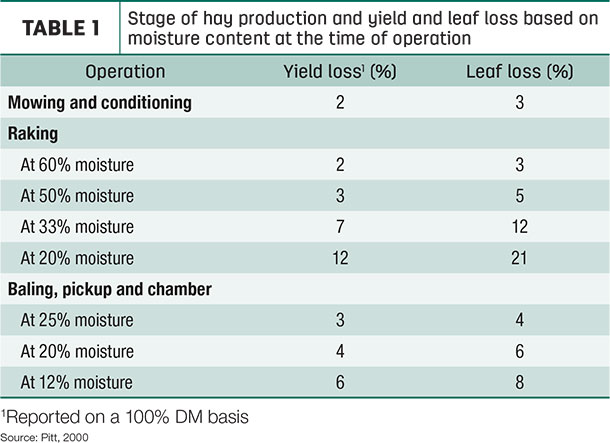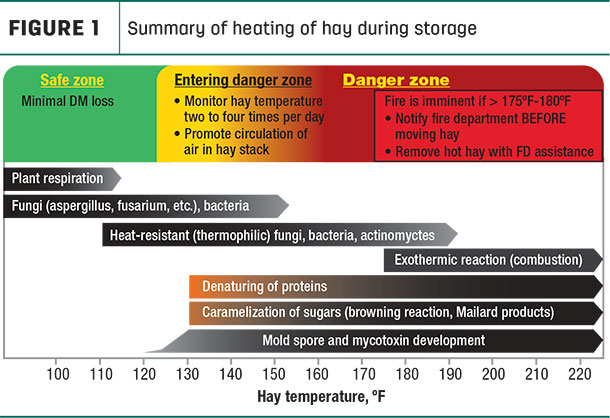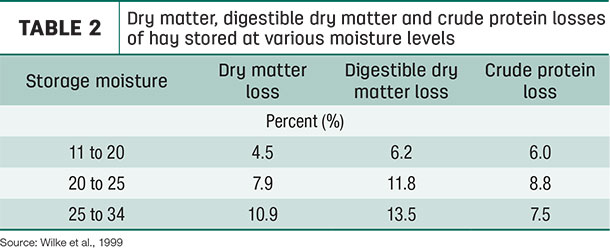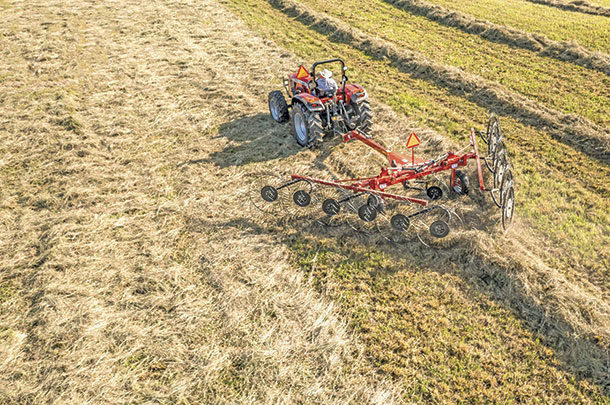Delivering the highest-quality hay is a complicated race against time. Quality begins to diminish after cutting and continues to decline through raking, baling and storage. With only a short window of optimal working time, taking preemptive steps to maximize efficiency and preserve crop nutrients is essential. It all starts with thoughtful planning and careful equipment selection.
Here are six tips to help maximize forage quality during the hay harvest process.
1. Select the right conditioner
In most environmental conditions, conditioning forage decreases drydown time and reduces the time until baling, potentially leading to a greater-quality forage. It exposes the stem or waxy cuticle and stops plant respiration sooner than an unconditioned forage, speeding up the drying process. Maximizing this time-saving benefit starts with selecting the right conditioner based on forage species.
Tine or impeller conditioner systems work well for grass crops, since these implements break the waxy cuticle without shattering the leaves, where most of the highly digestible nutrients are found. According to an article by Dr. Dan Undersander, leaves have two to three times the protein content of stems, and the leaf fraction of alfalfa accounts for up to 70% of its relative feed quality (RFQ). Additionally, the neutral detergent fiber (NDF) of the leaves is more digestible than stem NDF, making leaf retention a critical aspect of forage quality preservation. Likewise, the highest-quality nutrients are found in the leaves of grass species as well. For impeller conditioners, crop conditioning depends on the deflection shield position above the impeller and conditioning intensity.
Impeller conditioners can be used in alfalfa. However, rotor speed should be reduced by 70% to retain leaves. Otherwise, a roller conditioner might be a better choice. This type of implement crimps the stem to accelerate drydown and reduce respiration faster. A study in 2000 observed a 6.3% leaf loss when using an impeller conditioner compared to only 4.7% with a roller conditioner. A 1/16-inch to 1/32-inch gap is ideal for roller conditioners to ensure uniform crimping across all stems.
Additionally, some manufacturers offer a double conditioner. This option crimps the crop every 1.5 to 2 inches compared to the 3 to 4 inches on a single conditioner. In field trials, double-conditioned alfalfa was about 5% drier at the 24-hour point and remained 3% to 6% drier throughout the drying process. With an average drydown rate of 1.3% per hour compared to 1% for single-conditioned forage, the double conditioner offers producers a chance to bale several hours earlier, maximizing relative feed value (RFV).
2. Use sharp knives
Working with sharp knives is essential for a clean cut. Dull knives can leave crop in the field, wasting valuable dry matter. Sharp knives also ensure forage grows back quickly. Check the owner’s manual for knife maintenance guidelines and always start the season out with new, sharp blades.
To maximize efficiency, look for a low-profile cutter bar. This allows producers to achieve a low cut without additional tilting, which can increase ash content in a swath. Additionally, cutter bars with quick-change knives further increase machine uptime by allowing producers to replace blades in the field single-handedly and with only common tools. For the most cost-effective and durable cutter bar options, look for manufacturers that offer a three-year factory warranty.
3. Rake at proper moisture levels
Deciding when to rake can be challenging, especially when Mother Nature isn’t cooperating. Producers must balance forage moisture and drydown needs. Raking too soon can result in high moisture content, which can lead to potential heating issues during baling and greater respiration losses (sugar depletion) in the windrow. Raking hay after too much drydown, on the other hand, can cause significant leaf loss. This reduces the leaf-to-stem ratio and causes a sharp decline in forage quality. Table 1 shows the results of a study quantifying leaf loss by dryness at raking.

Raking at a 35% to 40% moisture window provides the best balance of proper moisture for continual drydown and forage quality preservation.
4. Ensure proper rake settings
Making sure rake settings are calibrated for a specific field and forage type goes a long way to improve overall quality. Rakes with tines that dig into the soil surface deposit more dust (ash) and debris on the hay. Correctly setting the rake height reduces soil contamination, resulting in lower ash levels. Adjust the rake height on a level spot in the field and make sure tines are well above the soil surface but not higher than mowed stubble height. Keep in mind, setting the rake too high can leave dry matter in the field, reducing crop yield, so it’s important to adjust equipment to fit the field.
To gently lift and form a windrow from a swath, it’s important to sync the power take-off (PTO) speed and the field speed of the rotary rake. A PTO speed too fast can cause excessive leaf loss and non-uniform windrows.
Additionally, it’s important to match windrow width with baler pickup. Windrows wider than the baler pickup can leave anywhere from 5% to 10% dry matter in the field. Look for a rake that offers easy width adjustment and straightforward, dependable construction for maximum efficiency and long-term value.
5. Keep an eye on moisture content and density
Maintaining ideal moisture is also important throughout the baling process. Incorrect moisture at baling can pose another great risk for dry matter yield loss.

Baling forage that is too dry has a tendency for leaf shatter, resulting in significant nutrient and dry matter loss. Mowed forage lying on the ground can suffer dry matter losses of 5% to 6% a day. Mother Nature isn’t always on the producer’s side when it comes to baling. However, in dry climates or when hay has dried to less-than-ideal moisture, baling after dew has set in can help minimize dry matter loss. A steamer can also be used during baling to incorporate moisture.
Too much moisture at baling can also lead to dry matter losses and even more disastrous consequences. Hay with a greater-than-ideal moisture content poses a significant fire risk. But even slightly elevated bale temperatures can reduce forage quality due to denaturing proteins, caramelizing sugars and development of mold and mycotoxin.

Moisture content at baling should be aligned with bale density and type of bale for optimal results. Less dense bales, such as small square bales and most round bales, can be baled at 14% to 16% moisture. Densely packed large square bales, on the other hand, should be baled around 12% moisture.
6. The importance of cut length
Research has shown that cut length of forage during baling correlates to animal performance. Shorter lengths of cut in corn silage resulted in an increased intake potential and digestibility, which led to a positive impact on animal performance.
Using a baler with knives allows producers to quickly adjust cut length to maximize forage quality. Cut length can be matched to a number of factors, including state of maturity, weather losses during harvest and more. For example, reducing cut length for forage that is being harvested too late can increase potential intake and digestibility to optimize forage utilization and animal efficiency.
Maximizing forage quality is a season-long endeavor
There are plenty of challenges when it comes to producing high-quality, high-yield forage. Taking time to plan ahead and maximize efficiency through each phase of the process can lead to better hay. Optimizing hay production for specific forage species and field conditions might mean rethinking forage management practices or shifting to new processes and equipment. Working with dedicated hay equipment manufacturers, producers can determine the best tools and tactics for their individual operations.











